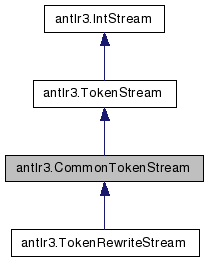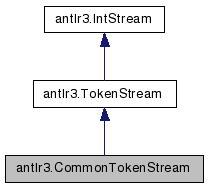antlr3.CommonTokenStream Class Reference
The most common stream of tokens. More...


Public Member Functions | |
| def | __init__ |
| def | setTokenSource |
| Reset this token stream by setting its token source. | |
| def | reset |
| def | fillBuffer |
| Load all tokens from the token source and put in tokens. | |
| def | consume |
| Move the input pointer to the next incoming token. | |
| def | skipOffTokenChannels |
| Given a starting index, return the index of the first on-channel token. | |
| def | skipOffTokenChannelsReverse |
| def | setTokenTypeChannel |
| A simple filter mechanism whereby you can tell this token stream to force all tokens of type ttype to be on channel. | |
| def | discardTokenType |
| def | getTokens |
| Given a start and stop index, return a list of all tokens in the token type set. | |
| def | LT |
| Get the ith token from the current position 1. | |
| def | LB |
| Look backwards k tokens on-channel tokens. | |
| def | get |
| Return absolute token i; ignore which channel the tokens are on; that is, count all tokens not just on-channel tokens. | |
| def | LA |
| Get int at current input pointer + i ahead where i=1 is next int. | |
| def | mark |
| Tell the stream to start buffering if it hasn't already. | |
| def | release |
| You may want to commit to a backtrack but don't want to force the stream to keep bookkeeping objects around for a marker that is no longer necessary. | |
| def | size |
| Only makes sense for streams that buffer everything up probably, but might be useful to display the entire stream or for testing. | |
| def | index |
| Return the current input symbol index 0. | |
| def | rewind |
| Reset the stream so that next call to index would return marker. | |
| def | seek |
| Set the input cursor to the position indicated by index. | |
| def | getTokenSource |
| Where is this stream pulling tokens from? This is not the name, but the object that provides Token objects. | |
| def | getSourceName |
| Where are you getting symbols from? Normally, implementations will pass the buck all the way to the lexer who can ask its input stream for the file name or whatever. | |
| def | toString |
| Return the text of all tokens from start to stop, inclusive. | |
Public Attributes | |
| tokenSource | |
| channelOverrideMap | |
| discardSet | |
| channel | |
| discardOffChannelTokens | |
| p | |
| lastMarker | |
Detailed Description
The most common stream of tokens.The most common stream of tokens is one where every token is buffered up and tokens are prefiltered for a certain channel (the parser will only see these tokens and cannot change the filter channel number during the parse).
Definition at line 1567 of file antlr3.py.
Member Function Documentation
| def antlr3.CommonTokenStream.__init__ | ( | self, | ||
tokenSource = None, |
||||
channel = DEFAULT_CHANNEL | ||||
| ) |
- Parameters:
-
tokenSource A TokenSource instance (usually a Lexer) to pull the tokens from. channel Skip tokens on any channel but this one; this is how we skip whitespace...
Reimplemented in antlr3.TokenRewriteStream.
| def antlr3.CommonTokenStream.setTokenSource | ( | self, | ||
| tokenSource | ||||
| ) |
| def antlr3.CommonTokenStream.fillBuffer | ( | self | ) |
| def antlr3.CommonTokenStream.consume | ( | self | ) |
Move the input pointer to the next incoming token.
The stream must become active with LT(1) available. consume() simply moves the input pointer so that LT(1) points at the next input symbol. Consume at least one token.
Walk past any token not on the channel the parser is listening to.
Reimplemented from antlr3.IntStream.
| def antlr3.CommonTokenStream.skipOffTokenChannels | ( | self, | ||
| i | ||||
| ) |
| def antlr3.CommonTokenStream.skipOffTokenChannelsReverse | ( | self, | ||
| i | ||||
| ) |
| def antlr3.CommonTokenStream.setTokenTypeChannel | ( | self, | ||
| ttype, | ||||
| channel | ||||
| ) |
A simple filter mechanism whereby you can tell this token stream to force all tokens of type ttype to be on channel.
For example, when interpreting, we cannot exec actions so we need to tell the stream to force all WS and NEWLINE to be a different, ignored channel.
| def antlr3.CommonTokenStream.discardTokenType | ( | self, | ||
| ttype | ||||
| ) |
| def antlr3.CommonTokenStream.getTokens | ( | self, | ||
start = None, |
||||
stop = None, |
||||
types = None | ||||
| ) |
| def antlr3.CommonTokenStream.LT | ( | self, | ||
| k | ||||
| ) |
Get the ith token from the current position 1.
.n where k=1 is the first symbol of lookahead.
Reimplemented from antlr3.TokenStream.
| def antlr3.CommonTokenStream.LB | ( | self, | ||
| k | ||||
| ) |
| def antlr3.CommonTokenStream.get | ( | self, | ||
| i | ||||
| ) |
Return absolute token i; ignore which channel the tokens are on; that is, count all tokens not just on-channel tokens.
Reimplemented from antlr3.TokenStream.
| def antlr3.CommonTokenStream.LA | ( | self, | ||
| i | ||||
| ) |
Get int at current input pointer + i ahead where i=1 is next int.
Negative indexes are allowed. LA(-1) is previous token (token just matched). LA(-i) where i is before first token should yield -1, invalid char / EOF.
Reimplemented from antlr3.IntStream.
| def antlr3.CommonTokenStream.mark | ( | self | ) |
Tell the stream to start buffering if it hasn't already.
Return current input position, index(), or some other marker so that when passed to rewind() you get back to the same spot. rewind(mark()) should not affect the input cursor. The Lexer track line/col info as well as input index so its markers are not pure input indexes. Same for tree node streams.
Reimplemented from antlr3.IntStream.
| def antlr3.CommonTokenStream.release | ( | self, | ||
marker = None | ||||
| ) |
You may want to commit to a backtrack but don't want to force the stream to keep bookkeeping objects around for a marker that is no longer necessary.
This will have the same behavior as rewind() except it releases resources without the backward seek. This must throw away resources for all markers back to the marker argument. So if you're nested 5 levels of mark(), and then release(2) you have to release resources for depths 2..5.
Reimplemented from antlr3.IntStream.
| def antlr3.CommonTokenStream.size | ( | self | ) |
Only makes sense for streams that buffer everything up probably, but might be useful to display the entire stream or for testing.
This value includes a single EOF.
Reimplemented from antlr3.IntStream.
| def antlr3.CommonTokenStream.index | ( | self | ) |
Return the current input symbol index 0.
.n where n indicates the last symbol has been read. The index is the symbol about to be read not the most recently read symbol.
Reimplemented from antlr3.IntStream.
| def antlr3.CommonTokenStream.rewind | ( | self, | ||
marker = None | ||||
| ) |
Reset the stream so that next call to index would return marker.
The marker will usually be index() but it doesn't have to be. It's just a marker to indicate what state the stream was in. This is essentially calling release() and seek(). If there are markers created after this marker argument, this routine must unroll them like a stack. Assume the state the stream was in when this marker was created.
If marker is None: Rewind to the input position of the last marker. Used currently only after a cyclic DFA and just before starting a sem/syn predicate to get the input position back to the start of the decision. Do not "pop" the marker off the state. mark(i) and rewind(i) should balance still. It is like invoking rewind(last marker) but it should not "pop" the marker off. It's like seek(last marker's input position).
Reimplemented from antlr3.IntStream.
| def antlr3.CommonTokenStream.seek | ( | self, | ||
| index | ||||
| ) |
Set the input cursor to the position indicated by index.
This is normally used to seek ahead in the input stream. No buffering is required to do this unless you know your stream will use seek to move backwards such as when backtracking.
This is different from rewind in its multi-directional requirement and in that its argument is strictly an input cursor (index).
For char streams, seeking forward must update the stream state such as line number. For seeking backwards, you will be presumably backtracking using the mark/rewind mechanism that restores state and so this method does not need to update state when seeking backwards.
Currently, this method is only used for efficient backtracking using memoization, but in the future it may be used for incremental parsing.
The index is 0..n-1. A seek to position i means that LA(1) will return the ith symbol. So, seeking to 0 means LA(1) will return the first element in the stream.
Reimplemented from antlr3.IntStream.
| def antlr3.CommonTokenStream.getTokenSource | ( | self | ) |
Where is this stream pulling tokens from? This is not the name, but the object that provides Token objects.
Reimplemented from antlr3.TokenStream.
| def antlr3.CommonTokenStream.getSourceName | ( | self | ) |
Where are you getting symbols from? Normally, implementations will pass the buck all the way to the lexer who can ask its input stream for the file name or whatever.
Reimplemented from antlr3.IntStream.
| def antlr3.CommonTokenStream.toString | ( | self, | ||
start = None, |
||||
stop = None | ||||
| ) |
Return the text of all tokens from start to stop, inclusive.
If the stream does not buffer all the tokens then it can just return "" or null; Users should not access $ruleLabel.text in an action of course in that case.
Because the user is not required to use a token with an index stored in it, we must provide a means for two token objects themselves to indicate the start/end location. Most often this will just delegate to the other toString(int,int). This is also parallel with the TreeNodeStream.toString(Object,Object).
Reimplemented from antlr3.TokenStream.
Member Data Documentation
The documentation for this class was generated from the following file:
 1.5.5
1.5.5